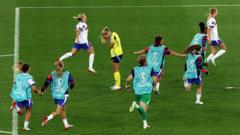What Makes a Penalty Shootout Extraordinary?

Understanding the Drama of Penalty Shootouts in Football
Penalty shootouts are often the climax of high-stakes football matches, bringing with them a unique blend of excitement, tension, and unpredictability. From the thrilling successes to the heart-wrenching failures, every shootout tells a story that resonates with fans and players alike. This article delves into some of the most memorable penalty shootouts in football history, the psychological aspects at play, and the statistics that reveal the true nature of this often-dreaded method of deciding a match.
The Anatomy of a Penalty Shootout
At its core, a penalty shootout is a test of skill, nerve, and psychological resilience. When 90 minutes of intense football ends in a draw, the teams face the daunting task of executing spot-kicks. The pressure is immense, as players know that their performance can either lead to glory or ignominy.
The Mechanics of Penalty Kicks
- The Player's Perspective: A player steps up to the spot, typically 12 yards away from the goal, with the weight of the match on their shoulders. The decision-making process encompasses choosing the direction, power, and type of shot (e.g., a powerful strike or a placed shot).
- The Goalkeeper's Challenge: The keeper must analyze the player's body language and previous kicks. They have to make a split-second decision on whether to dive left, right, or stay put.
Pressure and Psychology
The psychological aspects of a penalty shootout are profound. Players often experience a cocktail of emotions, including anxiety, confidence, and fear of failure. Factors influencing performance can include:
- Previous Experiences: A player with a history of successful penalties may feel more confident, whereas someone who has missed crucial kicks in the past may feel overwhelmed.
- Public Scrutiny: The eyes of millions of fans can heighten anxiety levels. The fear of becoming a scapegoat for a team's failure can weigh heavily on a player's mind.
- Team Dynamics: The support or pressure from teammates can influence a player's state of mind.
A Look Back at Iconic Penalty Shootouts
Throughout football history, certain penalty shootouts have etched themselves into the annals of the sport. Here are some of the most notable examples.
England vs. Sweden - Euro 2025
In a dramatic encounter at Euro 2025, England faced Sweden in a penalty shootout that would go down in history. Out of 14 penalties taken, only five found the back of the net. The shootout became a battle of nerves, with six penalties saved and three missed entirely by the Swedish side. This match highlighted the tension and unpredictability that comes with spot-kicks.
The 1986 European Cup Final
Another infamous shootout occurred during the 1986 European Cup Final between Barcelona and Steaua Bucharest. After a goalless 120 minutes, the shootout saw only 25% of penalties converted, with all four of Barcelona's attempts saved by Romanian goalkeeper Helmuth Duckadam. This match remains a stark reminder of how quickly fortunes can change in football.
Japanese Super Cup 2020
The Japanese Super Cup in February 2020 featured perhaps one of the most chaotic shootouts. Vissel Kobe and Yokohama Marinos saw a staggering nine consecutive penalties missed, with Yokohama's five consecutive misses highlighting the bizarre nature of this shootout.
Orlando City vs. New York City - MLS Playoffs 2020
One of the strangest shootouts occurred during the 2020 MLS playoffs between Orlando City and New York City FC. A series of events led to goalkeeper Pedro Gallese being sent off for stepping off his line, resulting in a substitute goalkeeper taking over. The shootout was filled with twists, including several retakes and a last-minute winner from Benji Michel, showcasing the unpredictable nature of penalty shootouts.
The Statistics Behind Penalty Shootouts
While the dramatic moments capture the heart of football, statistics provide insight into the realities of penalty shootouts.
Conversion Rates
Understanding the conversion rates of penalties can shed light on a team's performance under pressure. For example, England's 36% conversion rate against Sweden was the lowest in the history of the Women's Euros. Comparatively, the 2017 semi-final between Denmark and Austria had a conversion rate of 43% but was still riddled with missed opportunities.
Historical Trends
- Consistency: Research shows that teams with a structured approach to penalties, including practice and psychological preparation, tend to perform better.
- Goalkeeper Impact: Goalkeepers like Helmuth Duckadam and Jennifer Falk have demonstrated that exceptional shot-stopping can turn the tide in a shootout.
Training for Penalty Shootouts
Given the high stakes, many clubs now incorporate penalty practice into their training regimens. Here are some common methods:
- Simulated Pressure: Coaches create high-pressure scenarios during training to emulate the stress of a real shootout.
- Video Analysis: Players study past penalty shootouts to understand common strategies and tendencies of goalkeepers.
- Psychological Preparation: Mental conditioning techniques are employed to help players manage anxiety and enhance focus.
Conclusion
Penalty shootouts remain one of the most captivating aspects of football, encapsulating the thrill, unpredictability, and emotional weight of the sport. From historic encounters to bizarre incidents, each shootout adds to the rich tapestry of football history. Understanding the mechanics and psychology behind these moments can help fans appreciate the drama that unfolds when matches are decided from the spot.
As we reflect on the many memorable penalty shootouts, one question lingers—what will future shootouts hold for us? Will they continue to surprise, or will teams master the art of the penalty? Only time will tell.
Frequently Asked Questions
What is the history of penalty shootouts in football?
Penalty shootouts were introduced in the 1970 FIFA World Cup to resolve tied matches. Since then, they have become a staple in knockout competitions across the globe.
How are penalty shootouts structured?
Typically, each team takes five penalties in a shootout. If still tied after these initial attempts, the shootout goes to sudden death, where teams alternate shots until one team scores and the other does not.
What psychological factors influence players during shootouts?
Players often experience anxiety, fear of failure, and pressure from fans and teammates, all of which can impact their performance during a shootout.
Are there specific techniques players use when taking penalties?
Players often choose their shot placement and power based on their confidence and the goalkeeper's tendencies. Techniques can vary from powerful strikes to carefully placed shots aimed at the corners of the goal.
As we continue to witness the evolution of penalty shootouts, one must wonder—will we see a future where these moments are less about chance and more about skill and strategy? #PenaltyShootouts #FootballHistory #SportsPsychology
Published: 2025-07-18 11:32:03 | Category: sport



